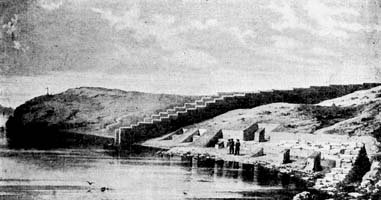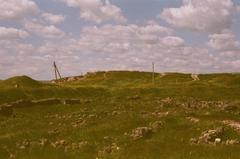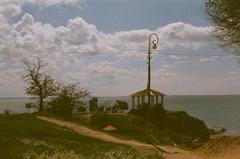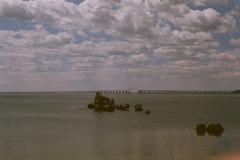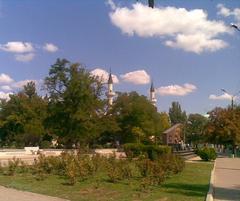Myrmekion Visiting Hours, Tickets, and Historical Sites Guide in Crimea
Date: 14/06/2025
Introduction to Myrmekion and Its Historical Significance
Myrmekion, situated on the northern coast of the Black Sea near modern-day Kerch, Crimea, is one of the region’s most significant ancient Greek archaeological sites. Established in the first half of the 6th century BCE by settlers from Miletus, the city was a vibrant center of trade, viticulture, and cultural exchange. Its proximity—just 4 kilometers northeast of ancient Panticapaeum (today’s Kerch)—helped it flourish as a vital hub within the Bosporan Kingdom, a Hellenistic state that exerted control across eastern Crimea and the Taman Peninsula from the 5th century BCE.
Ongoing excavations, led by the State Hermitage Museum since 1934, have revealed extensive remains, including fortified walls, residential quarters, necropolises, and religious sanctuaries. These discoveries offer deep insights into Myrmekion’s urban planning, daily life, and burial customs, as well as the seismic events that shaped its history. Despite the challenges presented by Crimea’s political complexities, Myrmekion remains accessible to visitors eager to experience the enduring legacy of Greek civilization on the Black Sea coast.
This guide provides comprehensive visitor information—from opening hours and ticketing to accessibility and nearby attractions—while highlighting Myrmekion’s historical and cultural importance. Whether you are an archaeology enthusiast, a scholar, or a traveler, this resource will help you appreciate and explore Myrmekion to the fullest.
For more detailed information on visiting and the site’s archaeological heritage, see HistoryGreek.org, the official Crimea travel portal (en.travelcrimea.com), and academic publications on SpringerLink.
Table of Contents
- Introduction
- Historical Overview
- Archaeological Features and Discoveries
- Economic and Cultural Significance
- Visitor Information
- How to Get There
- Nearby Attractions
- Travel Tips
- Frequently Asked Questions (FAQ)
- Visual and Interactive Resources
- Legacy and Modern Relevance
- Preservation Challenges
- Notable Artifacts and Finds
- Myrmekion in Crimean Heritage
- Conclusion
- Sources
Historical Overview
Prehistoric and Early Settlement
The area around Myrmekion has been inhabited since the Middle Paleolithic period, with evidence of Neanderthals and early modern humans dating back 80,000 years. Early agriculture and settlement activity intensified in the Chalcolithic period (mid-4th millennium BCE), with influences from the Yamna culture in the 3rd millennium BCE, linking the area to broader Proto-Indo-European migrations.
Greek Colonization and the Founding of Myrmekion
Founded in the early 6th century BCE by colonists from Miletus, Myrmekion’s strategic location on the Kerch Bay encouraged maritime trade and cultural interaction. Ancient geographers, including Strabo, noted its proximity to other significant settlements such as Parthenium and Achilleum, underlining its role in the network of Greek colonies along the Black Sea (Wikipedia; HistoryGreek.org).
Economic and Cultural Development
By the 5th century BCE, Myrmekion had become a center for winemaking and trade, minting its own coins and importing luxury goods and pottery. The construction of thick, towered defensive walls attests to both its prosperity and the need for protection against external threats.
Integration into the Bosporan Kingdom
In the 4th century BCE, Myrmekion became part of the Bosporan Kingdom, which later aligned as a Roman client state. Despite a gradual decline—due in part to the rise of nearby Panticapaeum—the settlement remained inhabited into the Roman and Byzantine eras, surviving invasions and changing rulers, including Khazars, Kievan Rus’, Byzantines, Genoese, and Ottomans.
Archaeological Rediscovery
Excavations began in 1934 and have continued under the State Hermitage Museum, revealing city walls, residential quarters, workshops, and a variety of artifacts that illuminate the daily life and multicultural environment of Myrmekion.
Archaeological Features and Discoveries
Fortifications and Urban Layout
The city’s substantial stone defensive walls date to its earliest occupation. Within these, archaeologists have identified a typical Greek colonial layout, including residential blocks, public spaces, and a central agora (HistoryGreek.org).
Residential and Public Buildings
Discoveries include foundations of houses, workshops, administrative buildings, market areas, and domestic shrines. These reflect a blend of Greek and indigenous architectural influences and point to a vibrant civic life.
Necropolis and Burial Practices
Myrmekion’s extensive necropolis features tumuli, cist graves, and chamber tombs. Grave goods—pottery, jewelry, weapons, and imported luxury items—highlight the city’s cosmopolitan nature and the coexistence of Greek, Scythian, and other cultural traditions.
Sanctuary of Demeter
A sanctuary dedicated to Demeter, partially reconstructed through recent studies, underscores the centrality of Greek religious practice and agricultural rites in Myrmekion’s community life (SpringerLink).
Evidence of Natural Disasters
Archaeoseismological research has documented multiple strong earthquakes that affected Myrmekion, with evidence of shifted and damaged walls. These seismic events, some reaching intensity IX on the MSK scale, occurred from the first millennium BCE through the early centuries CE, providing important data on ancient urban resilience (SpringerLink).
Economic and Cultural Significance
Trade and Commerce
Myrmekion’s strategic port facilitated exports of grain, fish, wine, and other goods, supporting trade links with the Greek world and beyond. The city also imported luxury ceramics and metalwork, and its coinage demonstrates economic integration within the Bosporan Kingdom (HistoryGreek.org).
Cultural Exchange
Artifacts from Myrmekion reflect interaction between Greeks and native peoples such as Scythians and Taurians. The blending of artistic styles, religious traditions, and daily practices illustrates the city’s role as a conduit for Hellenic culture and technology, while also absorbing local influences.
Visitor Information
Opening Hours and Tickets
- Hours: Open daily, generally from 9:00 AM to 6:00 PM (last admission 5:30 PM). Hours may vary seasonally or during restoration.
- Tickets: Admission is modest, usually 100–150 RUB for adults (under 500 RUB in some cases, depending on exchange rates). Discounts are available for students, children, and seniors. Tickets can be purchased onsite; online and advance booking options are limited.
- Guided Tours: Available in Russian and, by prior arrangement, in English. These tours provide valuable context and historical insight.
Facilities and Accessibility
- On-site Facilities: Basic amenities include informational signage, some rest areas, and parking. There is a small museum displaying key artifacts.
- Accessibility: Terrain is uneven and not fully accessible for those with mobility impairments; sturdy footwear is strongly recommended.
- Visitor Tips: Bring water, sun protection, and snacks, especially in summer; there are no large cafes or shops on the premises.
How to Get There
- Location: About 4 km northeast of central Kerch, close to the Yeni-Kale fortress (en.travelcrimea.com).
- By Car: Easily accessed by road, with parking available nearby.
- Public Transport: Local buses and taxis from Kerch serve the site.
- Tours: Many local tour operators and hotels offer packages that include Myrmekion.
Nearby Attractions
- Panticapaeum: The ancient capital of the Bosporan Kingdom atop Mount Mithridates, featuring extensive ruins and a lapidarium.
- Yeni-Kale Fortress: A preserved Ottoman stronghold adjacent to Myrmekion.
- Kerch Museums: The Kerch Historical and Archaeological Museum houses artifacts from Myrmekion and the broader region.
- Royal Burial Mounds: Notable kurgans such as Melek-Chesmensky are accessible via local transport.
Travel Tips
- Best Time to Visit: May to September offers the most pleasant weather.
- Entry Requirements: Most visitors enter Crimea via Russia; a Russian visa is required. Entering Crimea from Ukraine without authorization is illegal under Ukrainian law and may affect future travel to Ukraine. Always check the latest travel advisories.
- Currency: Russian ruble only; international credit cards may not work due to sanctions. Bring sufficient cash.
- Language: Russian is predominant. English is limited but available through some guides and signage.
- Safety: Avoid political gatherings and stay informed of current events. Carry necessary documents and travel insurance.
Frequently Asked Questions (FAQ)
Q: What are Myrmekion’s opening hours?
A: Typically 9:00 AM to 6:00 PM, with last entry at 5:30 PM. Check locally for updates.
Q: How much do tickets cost?
A: 100–150 RUB for adults, discounts for students and children. Purchase onsite.
Q: Are guided tours available?
A: Yes, in Russian and by arrangement in English. Booking ahead is recommended for English tours.
Q: Is the site wheelchair accessible?
A: Accessibility is limited due to uneven terrain.
Q: Can I buy tickets online?
A: Tickets are generally sold onsite. Some local tour operators may offer packages that include tickets.
Q: Is photography allowed?
A: Yes, for personal use. Permits may be required for commercial photography.
Visual and Interactive Resources
- Online virtual tours, maps, and images of Myrmekion’s fortifications and necropolis are available through heritage websites and tourism pages.
- Enhance your experience with high-resolution images and alt tags such as “Myrmekion city walls”, “Crimea archaeological site”, and “Greek ruins in Kerch”.
Legacy and Modern Relevance
Archaeological Research
Eighty years of excavations, led by Russian and Ukrainian archaeologists, have established Myrmekion as a key source for understanding Greek colonization and urbanism in Crimea (SpringerLink).
Educational Value
Myrmekion serves as a vital resource for scholars, students, and visitors interested in ancient trade, religion, and urban life, regularly appearing in academic literature on Greek and Black Sea archaeology.
Cultural Heritage and Tourism
Myrmekion is recognized as a site of outstanding archaeological and cultural value, featured in regional heritage lists and promoted for educational tourism (HistoryGreek.org; Pleiades).
Preservation Challenges
Crimea’s ongoing political situation presents challenges for site management, international research collaboration, and preservation. Risks of unauthorized excavations and changing administrative controls persist, but conservation efforts continue (CISS).
Notable Artifacts and Finds
- Pottery: Locally produced and imported Greek ceramics.
- Jewelry: Gold, silver, and bronze items reflecting Greek and Scythian styles.
- Inscriptions and Coins: Greek inscriptions and Bosporan Kingdom coinage, offering insights into the city’s economy and civic life (HistoryGreek.org).
These artifacts are displayed in regional museums and form the basis for ongoing research.
Myrmekion in the Context of Crimean Heritage
Myrmekion is integral to Crimea’s story as a crossroads of civilizations—from the Stone Age through Greek, Roman, Byzantine, and medieval periods. Its preservation and study enhance our understanding of the region’s complex cultural tapestry (CISS).
Conclusion
Myrmekion stands as a captivating testament to ancient Greek colonization, urban resilience, and cultural exchange in Crimea. Its well-preserved ruins, combined with modest visitor amenities and guided tours, make it an essential stop for travelers and scholars interested in the Black Sea’s historical heritage. Thoughtful preparation and responsible tourism will ensure a rewarding experience and help safeguard this unique site for generations to come.
Plan your visit by consulting the latest updates on official tourism websites, and consider using the Audiala mobile app for real-time travel tips and archaeological news. Explore Myrmekion to connect with the ancient world and enrich your understanding of Crimea’s past.
Sources and Official Links
- Myrmekion Ancient City: Visiting Hours, Tickets, and History of Crimea’s Greek Site, 2025, State Hermitage Museum (en.travelcrimea.com)
- Exploring Myrmekion: Visiting Hours, Tickets, and Historical Insights into Crimea’s Ancient Greek Colony, 2025, HistoryGreek.org (historygreek.org)
- Visiting Myrmekion Archaeological Site: Hours, Tickets, and Travel Tips for Exploring Crimea’s Ancient Gem, 2025, Travel Like a Boss (travellikeaboss.org)
- Archaeoseismological studies of Myrmekion, 2021, SpringerLink (springer.com)
- Cultural Heritage in Crimea, 2025, CISS (ciss.org.ua)
